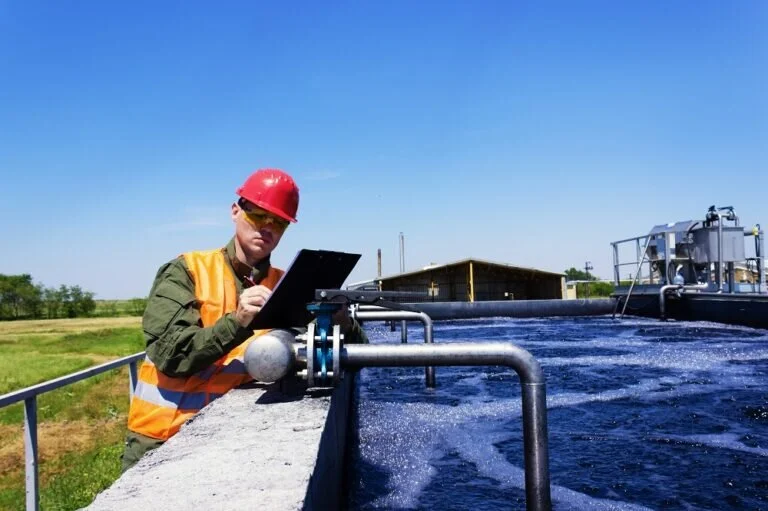The Importance of Safety Check-ins for Water Utility Companies
During the summer of 2018, the Canadian and American wastewater industries saw a number of above-average fatalities and injuries amongst their teams of loyal workers. The Canadian deaths were the result of fatal falls and there were two deaths at Texas-based wastewater treatment plan where the workers were exposed to fatal levels of hydrogen sulfide during routine repairs. These deaths were in addition to 10 people who were injured following an explosion at a water reclamation plant in Chicago.
What could have prevented these accidents? What could have the workers’ managers done beforehand to possibly prevent these horrible events from happening? While different safety steps could have been taken for each situation, an automated check-in system with fall detection for all of the workers mentioned may have saved their lives or at least lessened the severity of their injuries.
Water and wastewater workers face a number of safety hazards and risks. According to the Centers for Disease Control and Prevention, “workers who handle human waste or sewage may be at increased risk of becoming ill from waterborne diseases.” Their recommendations include stringent hygiene practices, the use of personal protective equipment as well as vaccinations to take as protection against any dangerous diseases.
Employers can elevate their worker protection strategies by including a check-in system to regularly receive confirmation the worker is safe as well as other technologies such location tracking, panic buttons, and fall detection in the case they become ill or find themselves in a dangerous situation.
Many safety hazards facing water industry
Due to the unique risks that workers are faced with, the Canadian water industry is one of the most hazardous and over-looked industry sectors in the country. The safety of those water workers who are still working to provide our country with essential water services is essential.
The concern is real around safety hazards facing water workers
Every water sector employer must have a plan for the occupational health and safety of their workers, including customized plans for lone worker safety programs. Among other important steps, this free guide will provide you with step-by-step breakdown on how to develop your own free lone worker program, a comprehensive program checklist that’s easy to follow and will keep you on track, as well as a simple worksheet that breaks down the components of developing your program.
*https://www.awwa.org/Portals/0/AWWA/Education/Webinars/2020PDFs/W200320_COVID-19_Handouts.pdf
Protecting your most important assets: your people
The nature of work in the field often requires water workers to work alone or in isolation. Common tasks for lone workers may include supervising wastewater plants, checking the water quality at reservoirs or secluded pumping stations, or monitoring remote meters. Their regular job responsibilities could involve high voltage materials, contact with contaminated water, toxic chemicals, releasing poisonous gases, and several other biological and chemical hazards. Since many water workers are required to work alone in the field, their risk of suffering from a workplace accident is magnified.
Managing your company’s risks and safety hazards
Water workers must be updated and educated on all company safety procedures. These will include both daily protocols, as well as emergency response procedures. Furthermore, employees must always be equipped with proper PPE and adequately exposed to the safety hazards in their workplaces. These practices are standard and essential to keeping your workers safe on the job.
Implementing a check-in system
Because of the unique hazards associated with the water industry, the implementation of a lone worker safety monitoring system is an effective way to protect your people - regardless of their location or work activity. With many of your employees working in remote locations or alone, the potential for an incident to occur and go undetected is high. A lone worker monitoring system eliminates this risk through a check-in system. Water workers can check-in at predetermined times throughout their shift to let their company know that they are safe. If a check-in is missed, your company will immediately know something is wrong.
The advantage of motion features in the field
In addition to proactive check-in timers, SafetyLine Lone Worker has incorporated motion features, including Fall Detection, Man-Down Detection, and Shake for Emergency. These features serve as an additional safety component for field workers. Fall detection is sensitive to fast movements toward that ground that could injure a worker. This is a valuable feature within the water industry, as field workers may be required to work at heights. Monitors will be alerted by Man-Down Detection if a device has not moved for an extended period, often the signal of an unconscious or injured worker. Man-Down Detection does not rely on a field worker’s ability to call for help, to call for help. Lastly, Shake for Emergency allows workers to quickly signal an emergency simply by shaking their device. SafetyLine’s motion features work simultaneously to ensure the safety of your lone water workers in the field.
Comprehensive safety
People working in the water face a wide range of occupational safety hazards and therefore require an equally comprehensive work safety plan that includes fundamental risk-mitigation measures like safety check-ins. No matter what time or in what location, water workers must have a means to check in and request help when they find themselves in an emergency.
Download our FREE hazard assessment guide below:
In the process of doing a hazard assessment for your workplace, it is almost a certainty you’ll learn information about the operational aspects of your organization you were unaware of prior to the assessment.


